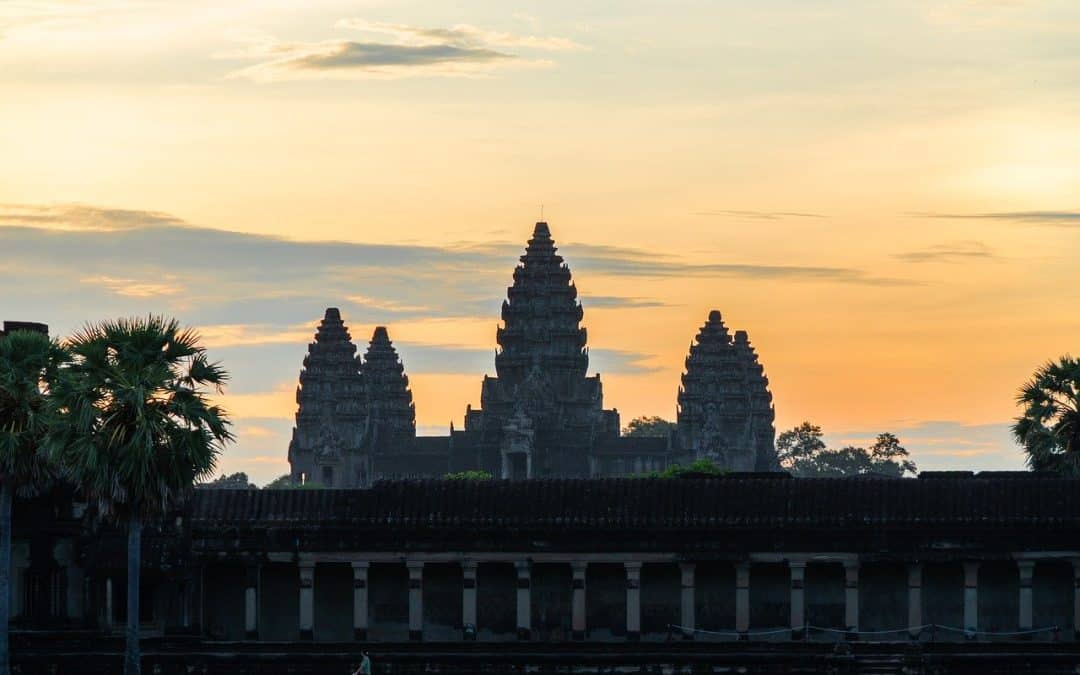Prepare to be enthralled as we embark on an extraordinary journey through time to answer the age-old question:
Is Angkor Wat the largest temple?
Angkor Wat is one of the largest and most impressive religious monuments globally, but it may not hold the title for the largest temple in terms of physical size, depending on the specific criteria used for comparison.
In this expedition, we will explore some of the most remarkable temple complexes from different corners of the world, each with its own unique history, architectural brilliance, and cultural significance.
From the mystical Bagan Temples in Myanmar to the awe-inspiring Karnak Temple Complex in Egypt, from the grandeur of the Great Temple of Tikal in Guatemala to the sacred space of the Great Mosque of Mecca in Saudi Arabia, we will venture into a world where ancient civilizations expressed their beliefs and aspirations through magnificent structures that have withstood the test of time.
Angkor Wat Temple, Cambodia
Situated in Cambodia, Angkor Wat is undeniably one of the largest and most impressive temple complexes in the world.
Constructed in the 12th century during the Khmer Empire, Angkor Wat covers an astonishing area of 402 acres, making it one of the most extensive religious monuments ever built. Its vast size is a testament to the remarkable engineering and architectural skills of the Khmer civilization, which flourished in the region at that time.
The temple’s design is a harmonious fusion of Hindu and Buddhist architectural styles, reflecting the religious syncretism of the era. Its five distinctive towers symbolize Mount Meru, the mythical abode of gods in Hindu cosmology.
Beyond its awe-inspiring size and design, Angkor Wat holds immense historical and cultural significance. Originally dedicated to the Hindu god Vishnu, it later transformed into a Buddhist temple, exemplifying the shifts in religious beliefs that occurred during the Khmer Empire.
Today, Angkor Wat stands as a symbol of Cambodia’s rich heritage and serves as a UNESCO World Heritage site, attracting travelers and history enthusiasts from around the globe. Exploring its majestic corridors and intricate bas-reliefs allows visitors to delve into a bygone era, offering a profound sense of freedom and wonder.
The Great Temple of Tikal, Guatemala
You may be surprised to learn that the Great Temple of Tikal in Guatemala is even larger than Angkor Wat.
The Great Temple, also known as Temple IV, is an architectural marvel that showcases the grandeur and skill of ancient Mayan civilization.
Standing at a staggering height of 64 meters, it towers over the surrounding jungle and offers breathtaking panoramic views.
The historical significance of Tikal cannot be overstated, as it was once a thriving city and political powerhouse in the Mayan world.
The Great Temple served as a ceremonial center and symbol of authority for the rulers of Tikal.
Its size and design reflect the Mayans’ advanced engineering capabilities and their deep understanding of astronomy.
Exploring this magnificent structure will transport you back in time to an era filled with wonder and discovery.
Bagan Temples, Myanmar
The awe-inspiring collection of ancient temples in Bagan, Myanmar will leave you breathless. The Bagan Temples are a testament to the architectural genius and historical significance of this region.
With over 2,000 temples spread across the vast landscape, it is truly a sight to behold. These temples were built between the 11th and 13th centuries by different kings and rulers, each adding their unique touch to the design.
The architectural features of these temples vary from simple structures to elaborate complexes with intricate carvings and stunning pagodas.
The historical significance of the Bagan Temples lies in their role as important religious centers for Buddhism during that time period. They served as places of worship and pilgrimage for devotees, attracting scholars and religious figures from all over Southeast Asia.
Exploring these magnificent temples will transport you back in time and give you a deep appreciation for the rich history and cultural heritage of Myanmar.
Borobudur, Indonesia
Immerse yourself in the ancient beauty of Borobudur, a remarkable testament to Indonesia’s rich cultural history. Built between the 8th and 9th centuries, Borobudur is not only one of the largest temples in the world but also a UNESCO World Heritage site.
This magnificent structure consists of nine stacked platforms adorned with intricate carvings and over 2,600 relief panels depicting Buddhist teachings. The temple was abandoned for centuries and suffered from volcanic eruptions and natural decay until its restoration efforts began in the early 20th century.
The restoration process involved meticulous research, archaeological expertise, and historical knowledge to ensure that Borobudur retained its original glory. Thanks to these efforts, visitors can now witness the grandeur of its unique architecture and marvel at its spiritual significance.
As you explore this sacred site, you will be captivated by the serene atmosphere and gain accurate insights into Indonesian history and culture. Borobudur stands as a symbol of freedom, offering a glimpse into an ancient civilization that continues to inspire awe today.
Karnak Temple Complex, Egypt
Step into the ancient world at Karnak Temple Complex in Egypt. You’ll be amazed by its vast size and the fact that it took over 2,000 years to construct. This monumental structure showcases the grandeur of ancient architecture and stands as a testament to human ingenuity and perseverance.
As you wander through its sprawling grounds, you’ll witness towering columns, intricately carved reliefs, and sacred sanctuaries that whisper tales of a bygone era. The historical significance of Karnak Temple Complex cannot be overstated. It served as the religious epicenter of the powerful New Kingdom pharaohs who sought to honor their gods and solidify their reign through magnificent temples.
Today, this awe-inspiring complex offers a glimpse into an extraordinary civilization. It invites you to explore its secrets with a sense of freedom and wonder.
The Great Mosque of Mecca, Saudi Arabia
Located in the heart of Saudi Arabia, the Great Mosque of Mecca transports you to a sacred realm where devotees gather in prayer and devotion. With its rich history and awe-inspiring architecture, this mosque holds immense cultural significance for Muslims around the world.
The origins of the Great Mosque of Mecca can be traced back to the time of Prophet Muhammad, making it one of the oldest religious sites in existence. Its majestic structure encompasses an area of over 356,000 square meters, making it one of the largest mosques in the world.
The focal point is the Kaaba, a cube-shaped building believed to have been built by Abraham and his son Ishmael. Every year, millions of Muslims from all corners of the globe embark on a pilgrimage known as Hajj to this holy site. The rituals performed at the Great Mosque of Mecca during Hajj symbolize unity, equality, and spiritual renewal.
This sacred space serves as a testament to Islamic heritage and continues to inspire believers worldwide with its profound sense of spirituality and devotion.
Conclusion
Angkor Wat may not be the largest temple in the world in terms of physical size when compared to other extraordinary temple complexes like the Great Temple of Tikal in Guatemala or the Great Mosque of Mecca in Saudi Arabia. However, it undeniably stands as one of the most impressive and significant architectural wonders ever built.
Throughout our journey, we have marveled at the diverse array of temples, each with its own captivating history, unique design, and cultural importance. From the ancient Mayan civilization in Guatemala to the rich Buddhist heritage of Myanmar and Indonesia, and the profound Islamic significance of Mecca, each temple offers a glimpse into the spiritual beliefs and achievements of our ancestors.
As we reflect on these awe-inspiring structures, it becomes evident that the world’s largest temple cannot be measured solely by its physical dimensions. Instead, it is the stories, the cultural heritage, and the enduring impact on humanity that truly define the greatness of these temples.
As we bid farewell to this extraordinary expedition, let us carry with us the appreciation for the architectural brilliance, historical significance, and cultural legacy of these magnificent temples. May we continue to explore and preserve the wonders of our past, cherishing the freedom to learn from and be inspired by the beauty of our shared human history.



